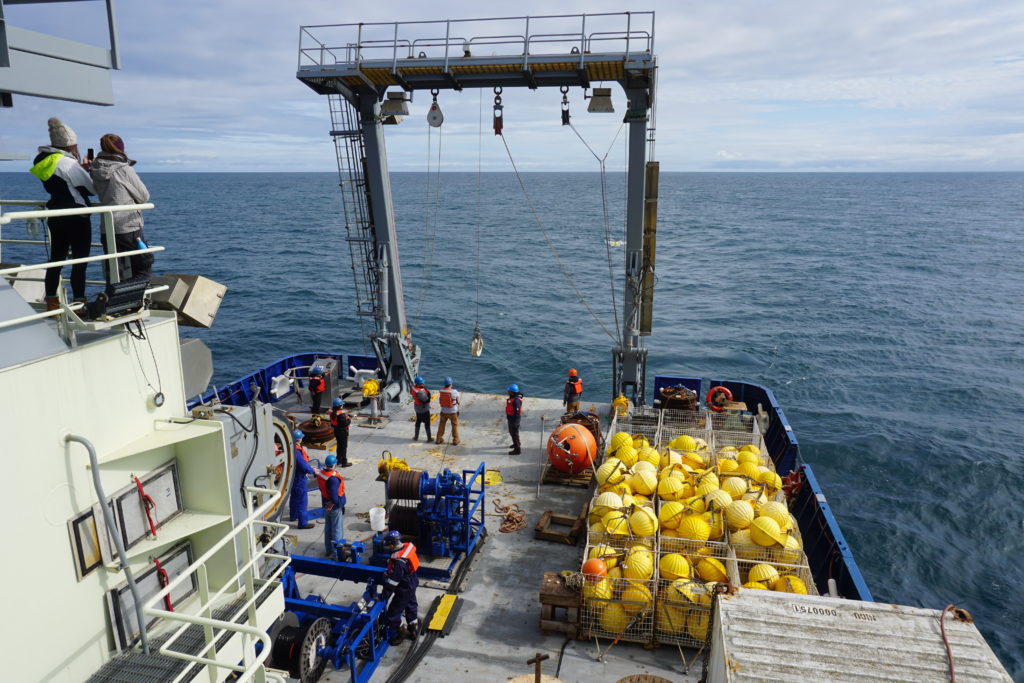by Femke de Jong

After four years the University of Miami and Royal Netherlands Institute for Sea Research (NIOZ) teams are once again out at sea together again. Four years ago we were here on the RV Neil Armstrong, together with the UK OSNAP (Overturning in the Subpolar North Atlantic) folks, to recover and deploy OSNAP moorings. Two years ago, we had planned to sail together on the Dutch RV Pelagia, but unfortunately due to COVID no international travel was possible in 2020 and the NL and US teams had to sail separately from their home ports on RV Pelagia and RV Armstrong. Fortunately, this year we are able to travel again and we can once again join forces on the Armstrong and sail from Reykjavik, Iceland.
Unfortunately, COVID is not gone and it’s still a hazard to those going to sea far away from hospitals and advanced medical care. We’re in close proximity to each other on board, with many of us sharing cabins. Each of us was required to get an official COVID test prior to boarding the cruise and testing was repeated once we came on board in Reykjavik. Sadly, even though we were all very careful and wore masks while travelling, one person did test positive in Reykjavik. After some back and forth between the ship and the ship’s office on shore, it was decided that the risk of taking that person on board was too great. So we had to leave port one person down. The rest of us have been testing daily to make sure no further problems show up unexpectedly.
The Armstrong left port on the morning of Friday 22 July. After some underway safety drills our first official activity was a test/training CTD in deep waters south of Iceland. The CTD is lowered over the side of the ship on a cable and measures Conductivity, Temperature and Depth from the ocean’s surface down to the bottom. We will do many CTD stations, both to calibrate the moored instruments and to get some data on the hydrography in the gaps between the moorings, so there are people in the CTD watches 24/7. For some of them, it’s the first time, so a training station is always good to do.
After another CTD station on Saturday, we arrive near the first CTD stations on the line on Sunday morning. Off our starboard bow was the RRS James Cook, carrying the UK OSNAP team. They had nearly finished their cruise and were down to deploy their last mooring on the line. By coincidence, as the dates of both cruises have shifted repeatedly over the last months, the Armstrong was there at the same time starting our line. Since such occasions are rare, we must make the most of them. The James Cook did a short flyby, sailby?, the Armstrong, we waved and wished them a good voyage home. By then it was time to get our own program started, with CTD stations towards the first mooring location.
On Sunday we got to the first mooring, which is the easternmost US mooring in the Iceland Basin. This is a relatively short (1000m) mooring that measures the deep flow. After some initial difficulties talking to the releases, which is done acoustically via the ship’s transducer, the mooring was successfully released and brought on board. In the afternoon, the mooring was deployed again with new instruments and batteries. This is the schedule we’ll follow for the next few weeks. CTDs overnight, mooring recovery in the morning, mooring deployment in the afternoon, a survey to determine the final mooring position and then back to CTDs. CTDs and Miami moorings will gradually become shallower as we move up the Mid Atlantic Ridge, and then deeper as we move down the Ridge to do the NIOZ moorings. All of this interspersed with excellent breakfasts, lunches, cheese 30s and dinners. Hopefully all will go smoothly…